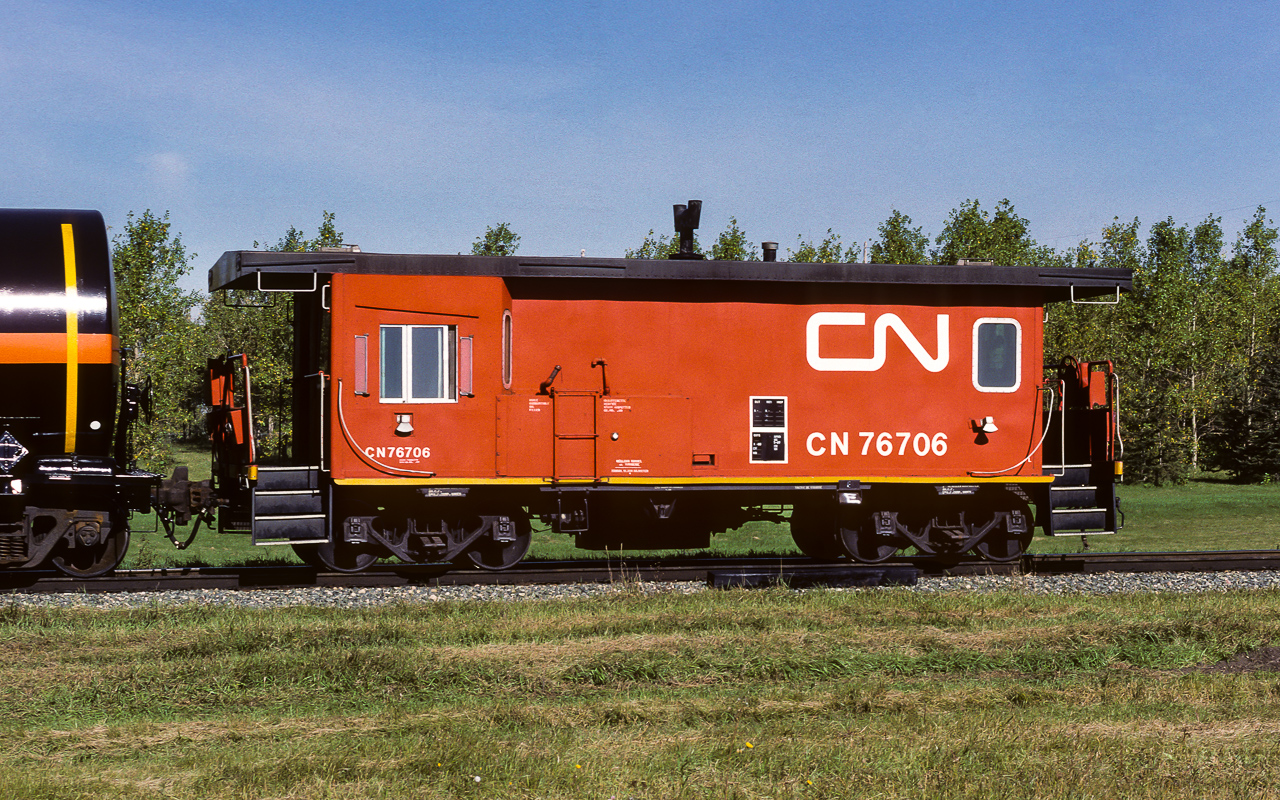
Welcome Visitor. First time here? Like what you see? Bookmark us for when you are bored, and check out 'top shots' and 'fantastic (editors choice)' in the menu above, you won't be dissapointed. Join our community!
click here to sign up for an account today. Sick of this message? Get rid of it by
logging-in here.



Great looking photo and caboose Larry.
These “transfer vans” we not constructed for road work. They are were used only in yard and transfer service. They were awesome to work in.. You are correct, they did disappear very quickly.
Did see a few of these around Burlington (Ont) years ago, but did not get a shot of one anywhere near as nice as this.
@Jason-thanks for the swell comment.:-)
 I am like you, I have a tough time searching this site and coming up with meaningful results. The one thing I did find on these cabs is a photo by Mel McInnis, http://www.railpictures.ca/upload/cn-76550-transfer-caboose-iin-the-merriton-yards His photo shows cab 76550 at Merriton Ont. from 1980. That’s over a 150 of these cabs if all those numbers were filled between 550 & 706. I find that somewhat amazing.
I am like you, I have a tough time searching this site and coming up with meaningful results. The one thing I did find on these cabs is a photo by Mel McInnis, http://www.railpictures.ca/upload/cn-76550-transfer-caboose-iin-the-merriton-yards His photo shows cab 76550 at Merriton Ont. from 1980. That’s over a 150 of these cabs if all those numbers were filled between 550 & 706. I find that somewhat amazing.
@4u-re-reading my caption, the last sentence is not the clearest. I was trying to say that these little yard cabs didn’t stand a chance of surviving long with so many road cabs coming available. When road cabs were eliminated from the ends of trains, what would you sooner have ridden around in. I worked and rode in both, I will take the road cab, very toasty in the winter.
@Arnold-thanks for the nice comment Arnold.
These cabs showed up in the Edmonton area in 78/79. Replacing the wooden cabs that we used on spur jobs. They were not well received or treated very nice. Those wooden cabs had an aura about them that truly was railroading. The older men that held those day jobs totally matched their equipment. The last of the old time railroaders. The same must have happened as diesels replaced steam.
What happened to these transfer vans? Were they scrapped? Seem like good use for shoving platforms.
I don’t know what happened to all these transfer cabeese, but I did check my 1986 CDN Trackside Guide and it lists 210 of these creatures built from 40 Ft box cars from 1977 to 1980. In 1986 208 survived.
Note the yellow vertical reflective stripe on the end of the tank car, a DOW initiative well ahead of the current mandated requirement. Note also, the orange horizontal stripe, a Canadian ONLY requirement for tank cars involved in the shipping of so called ‘Toxic Inhalation Hazard’ (TIH) commodities. The white reflective dot is also a Canadian ONLY requirement. Guessing that this is a freshly painted PROX chlorine tank car. Would there be a photo to verify??
Stuart- To the left of the empty placard holder (I cropped the photo a little on the edges), it reads Vinyl Chloride (PVC being one of the items produced at DOW) and underneath are the other tidbits, such as the BLT date of 2 79 and underneath this is the Converted date of 8 87. Thereby, it would seem, this car is fresh from being converted. Could be making its first trip after conversion. Does any of this help?
I went and dug out the box of slides to see if there was another photo of this scene which might have shown the end of the car and its number. Nope, this is shot number 38 on a 36 roll and this caboose was a good subject to fill that last frame with. All the other photos are coverage of the last train through Ft. Sask.
I would love to see more of the ceremony pictures from that day Larry! Is there a way you could share your pics (good and bad) with me? I’m trying to find some pics of the Fort from that time. Awesome shot btw! ????
Hi Larry. Yes, most helpful. Vinyl Chloride Monomer (VCM) is also a TIH. This is a Procor owned PROX tank car leased to Dow. The ‘Converted 8-87′ is a reference to a federally mandated program known as ‘HM-175′ whereby thermal insulation was installed. This would have involved removing the tank jacket, applying a blanket of thermal insulation, and re-installing the jacket. After so much work, a repaint would have been warranted. Great photo, BTW. My favourite era.
Your welcome Stuart, glad I could be of help.
To Jenn Loves Trains – stayed tuned in the new year. I will post a few of my photos from that day.
Awesome! I am awaiting with eager anticipation!